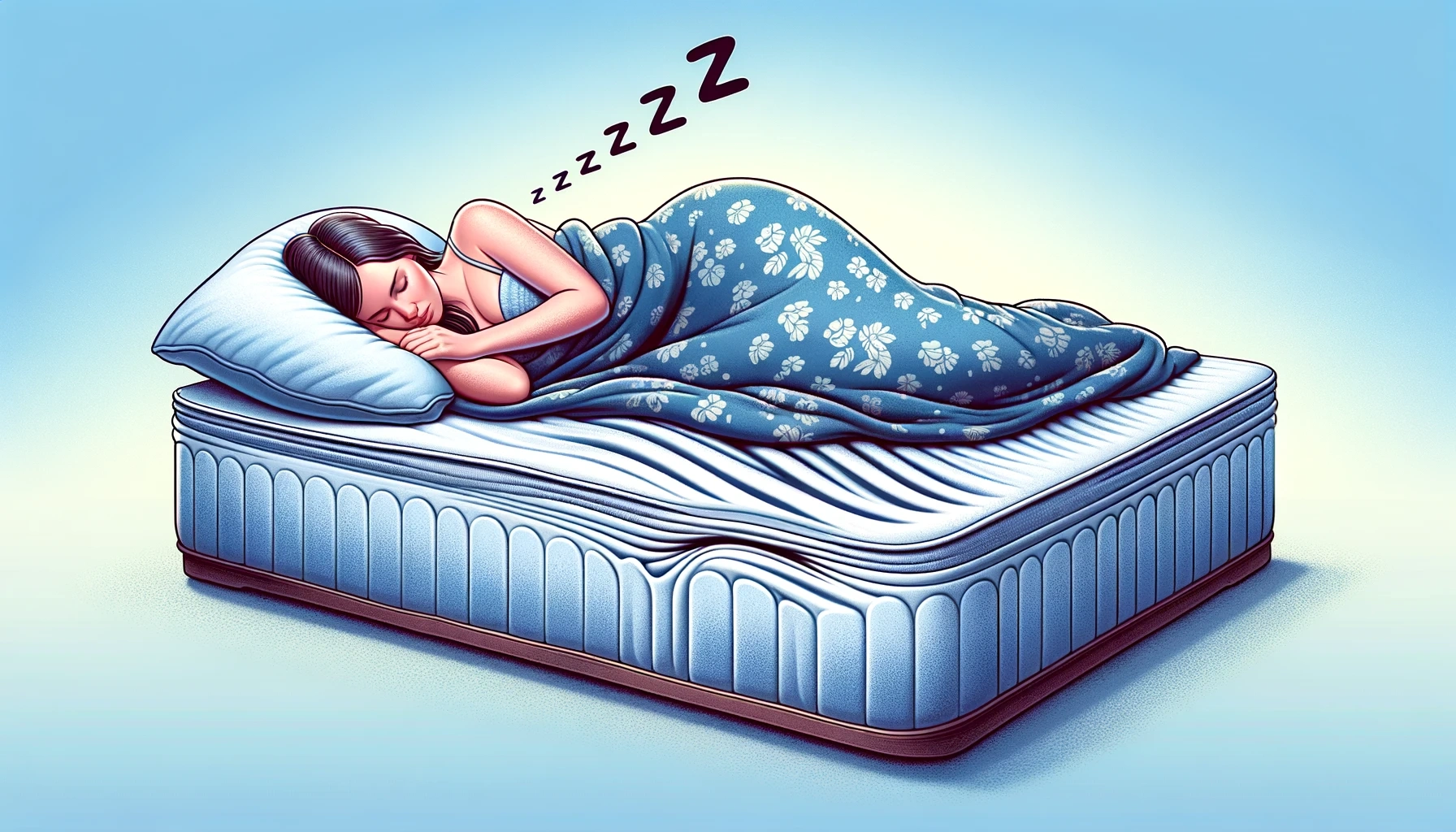A good night's sleep is extremely crucial for our general well-being. However, sagging mattresses might harm the quality of our sleep. Mattresses can droop or dent over time, causing us discomfort and disrupting our sleep.
You do not necessarily need to purchase a new mattress when this occurs. In this article, we look at whether it's possible to repair a sagging mattress and give you some helpful ideas to keep it from sagging in the first place.

Why Does a Mattress Sag and Sink?
- Body Weight and Pressure Points: In areas where pressure is stronger, frequent use without sufficient support can cause sinking.
- Mattress type: A memory foam mattress with a support frame is likely to last longer than an innerspring or hybrid mattress because of the way its coils break down.
- Foundation: Inadequate foundation might cause mattresses to flatten, sag, or sink too soon. Less than six-leg foundations sometimes result in early sagging.
- Lack of Proper Support: The bed foundation or frame, or any other support structure beneath the mattress, is essential to keeping the mattress's form and preventing sagging, which may result from an insufficient or worn-out mattress support system.
- Low Quality: A mattress may be built of low-quality materials that need more sturdiness to endure frequent usage and may degrade more quickly, causing the mattress to sag earlier.
- Wear and Tear: Mattresses deteriorate over time due to constant use. The components within, such as foam or springs, may begin to degrade and lose their original form. Continuous pressure from lying on the mattress might cause sagging over time.
- Sleeping Partners: The weight of our bodies, and our sleeping postures, can impose additional strain on specific sections of the mattress. Over time, this repetitive pressure can cause those regions to droop and develop mattress indents, particularly in locations where we frequently sleep, such as the hips and shoulders.
How to Fix a Sagging Mattress
1) Use a Mattress Topper
Consider using a mattress topper to protect your mattress against spills, stains, dust, perspiration, and body oils. It helps to preserve the mattress's condition by avoiding early sagging caused by these factors.
A mattress Topper adds an extra layer of protection to the mattress, increasing its lifespan and assuring long-term comfort.
2) Flip and Rotate the Mattress
Regularly rotating the mattress can help avoid sagging by spreading the weight and pressure more evenly over the surface. By rotating the mattress, you shift the places that carry your body's weight, lowering the risk of excessive compression and indentations in certain locations.
This contributes to the mattress's long-term support as it promotes equal wear and tear, preventing lasting body imprints and drooping in certain places.
We recommend rotating the mattress every 3 to 6 months to ensure more balanced usage and extend the longevity of the mattress.
3) Replace the Foundation
Mattress sinking can sometimes be attributed to the foundation of your bed. Because there is less support in the middle of the mattress, foundations with fewer than six legs frequently result in early drooping.
Slat-based foundations, which consist of sturdy wood planks or metal beams that lie across the bed frame and attach to the sides of the frame, can also result in sagging problems, especially in places where the slats don't support one other.
4) Use More Pillows
Placing more pillows strategically in areas where the mattress has sagged or lost support is another "hack" for fixing sagging. You may assist fill up the spaces and providing a smoother surface by positioning cushions beneath the drooping sections.
When it comes to little dips or drooping, such as those in the center of the mattress or close to the borders, this may be quite beneficial. Try arranging the pillows in different positions to determine which arrangement would be the most supportive and comfy for your particular sagging problems.
5) Check Your Mattress Warranty
The majority of premium mattresses have rather extensive warranties. Remember that regular wear and tear is often not covered, and not all sagging is regarded as a fault.
Consequences Of Having A Saggy Mattress
Your general quality of life and sleep may be impacted by the sagging of your mattress.
The following are some of the effects of sagging:
- Sleeping hot: A larger portion of your body is pressured when you sink into the mattress. Because of the restricted air movement, this may trap heat. Not only is it difficult to sleep hot, but it may also cause insomnia, which can make you tired throughout the day and cause irritation.
- Aches and pains: When a mattress sinks, less tension is needed to sustain your weight. When you wake up, this may cause general aches and pains, lower back discomfort, and neck pains.
- Feeling uncomfortable: It's not pleasant to sleep on an uneven surface. This may result in waking up during the night in addition to making it difficult for you to go to sleep because of the soreness and aches the discomfort might cause to your back and neck.
- Noise: The springs in an innerspring mattress may become more audible if the coil strength and supporting foam or pillow top layer are eroding. This may cause you or your partner to toss and turn during the night.
Tips on How to Prevent Your Mattress from Sagging
Change Where and How You Sleep
This simple tip, though seemingly obvious, can be surprisingly effective. If you sleep solo, switch your pillow arrangement each week: left side one week, right side the next, center the third. For couples, swap sides weekly or every other night. This distributes pressure evenly across the mattress, reducing wear and tear on specific areas and potentially minimizing sag.
Bonus: it can even refresh your sleep experience.
Regularly Rotate Your Mattress
Rotating most mattresses regularly is recommended, as the mattress can last a lot longer if you rotate it and switch the head and foot of the bed. A bed's early sagging can be avoided by flipping it every three to six months.
Rotating your mattress is still beneficial if it is already sinking. The parts of the mattress where the sleeper's body exerts the greatest pressure are prone to excessive sagging. This usually refers to the regions surrounding the shoulders and hips. By turning your mattress, you may place your heavier body parts in the regions that aren't currently drooping.
Use a Supportive Bed Frame
Use a sturdy bed frame that distributes weight uniformly and offers enough support. Also, avoid laying the mattress directly on the floor or utilizing a flimsy or broken frame.
Make sure the frame is the correct size for your mattress to avoid moving or bending and inspect the bed frame regularly for wear and damage.
Using a solid and correctly fitted bed frame will assist preserve your mattress's structural integrity and support, keeping it from drooping over time.
When to Replace Your Mattress
It's time to replace your mattress if you notice that it is not flat when you get up, has lumps, or is drooping excessively. These issues may keep you from sleeping, and result in back pain.
Additionally, an old mattress doesn't provide adequate support and makes it difficult to get a good night's sleep, so if you wake up feeling drowsy and achy, that's another indication that you need a new one.
Finally, if you can feel the springs poking through your existing one, it’s time for a replacement as it is not only unpleasant but also dangerous.
FAQs
Are sinking mattresses and body impressions the same thing?
These aren't the same. Body impressions are temporary indentations from your weight, like a cozy spot on your couch. Mattress sagging, on the other hand, is a gradual sinking or dipping of the entire surface.
What are some ways to reduce or avoid bodily impressions?
Rotate or flip your mattress regularly. This spreads out pressure evenly, reducing imprints. A topper can also add extra padding and minimize its depth.
If a mattress dips, is it fixable?
Minor sagging might be fixable. Try a topper or add support like slats or adjustable bases. But for severe dips, especially on older mattresses, a new one is often the best solution.
What typical reasons do mattresses sag?
Low-quality materials, an inadequately supported bed frame, wear, and maintenance methods, such as not routinely flipping or rotating the mattress, are some of the major reasons for drooping mattresses.
How long do body imprints or sinking mattresses take to happen?
Though it might happen sooner, imprints usually appear two to four years after the mattress is first used. Except for natural latex foam mattresses, almost all mattress types will eventually develop body imprints.
How do I know if my mattress is sagging?
Your bed is probably sinking if you notice that specific body parts, such as your shoulders, hips, or legs, sink too deeply into the mattress.
Can I fix my mattress that is sagging in the middle?
Yes, there's hope for a sagging mattress. Using a mattress pad or topper can smooth out the dip and provide extra support. Regular flipping or turning also helps distribute weight evenly. But if these tricks don't work, especially for an older or severely dipped mattress, it might be time to invest in a new one.
What type of mattress is least likely to sag?
Hybrids combining foam/latex with innerspring offer the best resistance to sagging, lasting up to 8 years without major dips.
Why is my mattress sagging after 1 month?
Sleeping in the same position every night, not turning it often enough, or even your weight, over 230 lbs, can contribute to early sagging in softer mattresses.
Do memory foam mattresses sag?
One disadvantage of one-sided foam beds is that memory foam mattresses may eventually sink or droop. This is because it cannot be turned to compensate for wear and tear.
Does a softer mattress sag more?
Softer mattresses with materials like cotton, wool, or alpaca are more prone to sagging. For heavier sleepers, over 230 lbs, firmer mattresses with a thick comfort layer offer better stability and durability.
Conclusion
Even while there are methods for correcting a sagging mattress, it's important to remember that prevention is always preferable to treatment.
Your mattress's longevity and ability to retain its form may be greatly extended by rotating and flipping it regularly, utilizing a sturdy bed frame, and getting a high-quality mattress protector—both of which may be covered by the guarantee.
Preventing sagging in the first place may be achieved by selecting a mattress with sturdy materials and appropriate support that fits your needs. You may have a supportive and comfy mattress for many years to come, which will guarantee pleasant sleep and enhanced general health.
Dom Abraham
As the lead content writer at Sleepiverse. Dom pours his heart into writing mattress reviews, bedding product reviews, and medically-reviewed health articles. Dom is from Portugal and likes to spend his free time writing on the beach as it gives him a sense of comfort. Aside from writing mattress reviews in front of the soothing beach view, Dom likes to experiment with new amazing food ideas.


